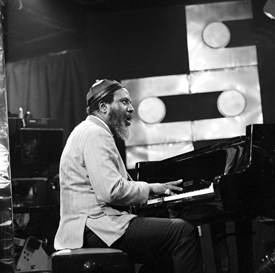 Thelonious Sphere Monk – October 10, 1917 ~ February 17, 1982, was an American jazz pianist and composer considered “one of the giants of American music”. Monk is the second most recorded jazz composer after Duke Ellington. His best known work includes, “Epistrophy”, “Round Midnight”, “Blue Monk”, “Straight, No Chaser and “Well, You Needn’t”.
Thelonious Sphere Monk – October 10, 1917 ~ February 17, 1982, was an American jazz pianist and composer considered “one of the giants of American music”. Monk is the second most recorded jazz composer after Duke Ellington. His best known work includes, “Epistrophy”, “Round Midnight”, “Blue Monk”, “Straight, No Chaser and “Well, You Needn’t”.
Monk is often credited with the foundation of bebop. His compositions consisting of improvisations, dissonant harmonies and angular melodic twists. This style was consistent with his piano style- which can be observed in the film- fused with high percussive attacks and abrupt, dramatic use of silences and hesitations.
Monk’s manner was said to be equally charismatic. His distinctive style of suits, hats and sunglasses were complimented by a unique stage performance. Monk would often stop playing during the his gig, stand and dance, whilst the other musicians would continue.
Monk was born in North Carolina in 1917, but grew up in New York. He started playing piano at 6 years of age and was largely self taught.
In 1940 Monk developed his style whilst working at Minton’s Playhouse, a Manhattan nightclub. A number of other influential jazz musicians would hang out here, including Dizzy Gillespie, Charlie Christian, Kenny Clarke, Charlie Parker and the great Miles Davis.
Monk made a number of early recordings between 1947-1954. First with Blue Note and later Prestige Records. During this period he recorded a number of highly significant, but at the time under-recognised albums, including collaborations with Sonny Rollins, Art Blakey and Max Roach. Monk also recorded with Miles Davis, but is said that Davis found this idiosyncratic accompaniment style difficult to improvise over and apparently asked Monk to sit out the recording, which rumor has it, nearly brought them to blows.
Monk later recorded with Riverside Recorded. Through this period he had his cabaret card restored by the New York authorities and went on to relaunch his New York career with a landmark six-month residency at the Five Spot Cafe in New York in 1957. Monk lead a quartet, with John Coltrane on tenor sax, Wilbur Ware on bass and Shadow Wilson on drums.
In 1962 Monk signed to Columbia Records, at the time considered to be one of the big four. Monk would record, “Monk’s Dream”, that would be his best selling LP of his lifetime.
By the mid-1970s, Monk had disappeared from the scene. Around this time Monk made his last recordings and made only a small number of appearances during this final decade. On a worldwide tour, “The Giants of Jazz”, Monk was said to be very withdrawn and refused to communicate with anyone. It is often speculated that Monk had an unspecified mental illness that worsened in the late 1960s, but no reports or diagnosis were ever publicized.
Monk died in 1982. He was posthumously awarded the Grammy Lifetime Achievement Award and the Pulitzer Prize Special Citation.

